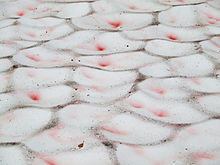Psychrophile
Many such organisms are bacteria or archaea, but some eukaryotes such as lichens, snow algae, phytoplankton, fungi, and wingless midges, are also classified as psychrophiles.The cold environments that psychrophiles inhabit are ubiquitous on Earth, as a large fraction of the planetary surface experiences temperatures lower than 10 °C.[6][4] Psychrophiles are protected from freezing and the expansion of ice by ice-induced desiccation and vitrification (glass transition), as long as they cool slowly.To accomplish this, psychrophiles adapt lipid membrane structures that have a high content of short, unsaturated fatty acids.[9] Antifreeze proteins are also synthesized to keep psychrophiles' internal space liquid, and to protect their DNA when temperatures drop below water's freezing point.[11] There is proof however it may be very effective – Gram positive bacteria Actinobacteria have been shown to have lived about 500,000 years in the permafrost conditions of Antarctica, Canada, and Siberia.[17][18] Some phytoplankton can tolerate extremely cold temperatures and high salinities that occur in brine channels when sea ice forms in polar oceans.[23] The wingless midge (Chironomidae) Belgica antarctica can tolerate salt, being frozen and strong ultraviolet, and has the smallest known genome of any insect.They provide an estimation of the product's shelf life, but also they can be found in soils,[25] in surface and deep sea waters,[26] in Antarctic ecosystems,[27] and in foods.The RecBCD enzymes are exchangeable between the psychrophilic P. syringae and the mesophilic E. coli when provided with the entire protein complex from same species.[19] Phytoplankton living in the cold ocean waters near Antarctica often have very high protein content, containing some of the highest concentrations ever measured of enzymes like Rubisco.



lichenXanthoria elegansphotosynthesizeextremophilicorganismsgrowthreproductionthermophilesmesophilesAncient Greekbacteriaarchaeaeukaryoteslichenssnow algaephytoplanktonwingless midgesChlamydomonas nivalispermafrostglacierssnowfieldsdeep oceandesiccationvitrificationunsaturated fatty acidscarotenoidsAntifreeze proteinsviable but nonculturable (VBNC)ArthrobacterPsychrobacterHalomonasPseudomonasHyphomonasSphingomonasChryseobacterium greenlandensisChironomidaeChlamydomonasAntarcticaMicroalgaeChloromonasChlorellasea icediatomsFragilariopsis cylindrusPenicilliumGrylloblattidaeBelgica antarcticagenomebase pairsfoodborne pathogensYersiniadairy industrypasteurizationCornell UniversityPseudomonas syringaediatomRoss SeaRubiscosupercoolingTipula paludosaHemideina thoracicaCryptocercus punctulatusEurosta solidaginisSyrphus ribesiiChionophileExtremophileHalophileIce algaeMesophileOsmophilePathogenic microorganisms in frozen environmentsThermophileXerophileBibcodePLOS OneElsevierCambridge University PressStenopelmatidaeExtremophilesAcidophileAlkaliphileCapnophileEndolithHypolithLipophileLithoautotrophLithophileMethanogenMetallotolerantOligotrophPiezophilePolyextremophilePsammophileRadioresistantHyperthermophileThermoacidophileChloroflexus aurantiacusDeinococcus radioduransDeinococcotaSnottiteThermus aquaticusThermus thermophilusSpirochaeta americanaGFAJ-1Pyrococcus furiosusStrain 121Pyrolobus fumariiThermococcus gammatoleransEukaryotaCyanidioschyzon merolaeGaldieria sulphurariaParalvinella sulfincolaHalicephalobus mephistoPompeii wormAbiogenic petroleum originAcidithiobacillalesAcidobacteriotaAcidophiles in acid mine drainageArchaeoglobaceaeBerkeley PitBlood FallsThermoproteotaHalobacteriaHalobacteriumHelaeomyia petroleiHydrothermal vent
